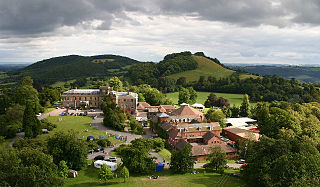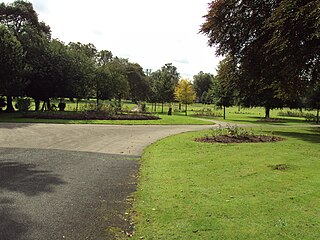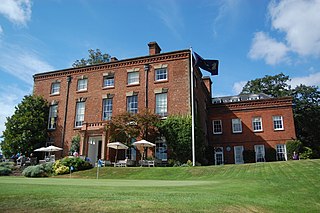
Lacock Abbey in the village of Lacock, Wiltshire, England, was founded in the early 13th century by Ela, Countess of Salisbury, as a nunnery of the Augustinian order. The abbey remained a nunnery until the suppression of Roman Catholic institutions in England in the 16th century; it was then sold to Sir William Sharington who converted the convent into a residence where he and his family lived. It was fortified and remained loyal to the crown during the English Civil War, but surrendered to the Parliamentary forces once Devizes had fallen in 1645.

Edgbaston is an affluent suburban area of southern Birmingham, England, historically in Warwickshire, and curved around the southwest of the city centre.

Beeston Castle is a former Royal castle in Beeston, Cheshire, England, perched on a rocky sandstone crag 350 feet (107 m) above the Cheshire Plain. It was built in the 1220s by Ranulf de Blondeville, 6th Earl of Chester (1170–1232), on his return from the Crusades. In 1237, Henry III took over the ownership of Beeston, and it was kept in good repair until the 16th century, when it was considered to be of no further military use, although it was pressed into service again in 1643, during the English Civil War. The castle was slighted in 1646, in accordance with Cromwell's destruction order, to prevent its further use as a bastion. During the 18th century, parts of the site were used as a quarry.

Sherborne Castle is a 16th-century Tudor mansion southeast of Sherborne in Dorset, England, within the parish of Castleton. Originally built by Sir Walter Raleigh as Sherborne Lodge, and extended in the 1620s, it stands in a 1,200-acre (490 ha) park which formed a small part of the 15,000-acre (61 km2) Digby estate. Within the grounds lie the ruins of the 12th-century Sherborne Old Castle, now in the care of English Heritage.
The Gough-Calthorpe family is descended from ancient and notable families who both held lands in the area around Birmingham, England.

Julius Alfred Chatwin FRIBA, ARBS, FSAScot was a British architect. He was involved with the building and modification of many churches in Birmingham, and practised both Neo-Gothic and Neo-Classical styles. His designs always included all of the carvings and internal fittings.

Annesley Hall is a Grade II listed country house near Annesley in Nottinghamshire, England and the ancestral home of the Chaworth-Musters family. The 13th-century park, 17th-century terraces and 19th-century pleasure gardens and walled gardens of the hall are Grade II* listed on the Register of Historic Parks and Gardens.

Holland William Hobbiss, was an English architect in the Birmingham area. He traded under the names Holland W. Hobbiss and Partners and Holland W. Hobbiss and M. A. H. Hobbiss.

Abberley Hall is a country house in the north-west of the county of Worcestershire, England. The present Italianate house is the work of Samuel Daukes and dates from 1846 to 1849. Since 1916 it has been occupied by Abberley Hall School. It is a Grade II* listed building. The gardens are listed as Grade II on the English Heritage Register of Historic Parks and Gardens of Special Historic Interest in England. In the area close to Stourport-on-Severn there are several large manor and country houses, among which Witley Court, Astley Hall, Pool House, Areley Hall, Hartlebury Castle and Abberley Hall are particularly significant.

Astley Castle is a ruinous moated fortified 16th century manor house in North Warwickshire, England. It has been listed as a Grade II* listed building since 1952 and as a Scheduled Ancient Monument since 1994. It was derelict and neglected since it was severely damaged by fire in 1978 whilst in use as a hotel and was officially a Building at Risk. The building reopened as a holiday let in 2012 after extensive and novel renovations that combine modern elements within the (mostly) renaissance remains. In 2013, Astley Castle won the Royal Institute of British Architects Stirling Prize for architecture, as an "exceptional example" of the blending of an ancient monument with modern architecture.



Barnabas O'Brien, 6th Earl of Thomond, son of Donogh O'Brien, 4th Earl of Thomond; succeeded his brother as earl, 1639; was lord-lieutenant of Clare, 1640–41: had his rents seized, 1644; admitted a parliamentary garrison to Bunratty Castle and went to England: joined Charles I; successfully petitioned parliament for £2,000 spent in the parliamentary cause.

Wiverton Hall is an English country house near Tithby, Nottinghamshire. By 1510 the former village of Wyverton had become impoverished and reduced to just four houses and a cottage. It was in that year completely depopulated by "emparkment", when George Chaworth enlarged his park by 254 acres. All but the Grade II* listed gatehouse of the mansion was destroyed in the English Civil War. The current house dates from 1814.

The siege of High Ercall Hall in High Ercall, Shropshire, England took place during the First English Civil War. There were a total of three sieges. In each of the sieges, the Hall was held by the Royalists and besieged by the Parliamentarians. The final and longest siege took place from July 1645 to March 1646, when the Royalist commander surrendered the hall to the Parliamentarians.

Sudbrook Park in Petersham was developed by John Campbell, 2nd Duke of Argyll in the early 18th century. Sudbrook House, designed for Argyll by James Gibbs and now Grade I listed by Historic England, is considered a fine example of Palladian architecture. The house and its surrounding park have been the home of the Richmond Golf Club since 1891.

Calthorpe Park is a public park in Birmingham, England, created in 1857 and managed by Birmingham City Council.

Cliffe Park Hall is a country house near Rudyard in Staffordshire, England. During its 200-year history, it has been a private residence, a golf club house and a youth hostel. The hall is a Grade II listed building.

Sir Richard Gough, of Edgbaston Hall, Warwickshire. and Gough House, Chelsea, was a British merchant and politician who sat in the House of Commons from 1715 to 1728.




















